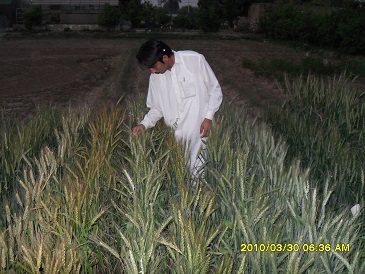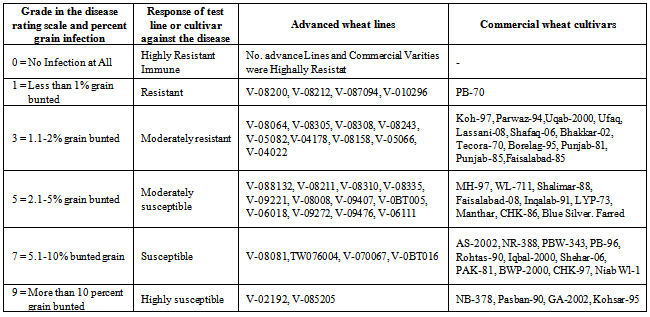-
Paper Information
- Next Paper
- Paper Submission
-
Journal Information
- About This Journal
- Editorial Board
- Current Issue
- Archive
- Author Guidelines
- Contact Us
International Journal of Plant Research
p-ISSN: 2163-2596 e-ISSN: 2163-260X
2013; 3(4): 47-51
doi:10.5923/j.plant.20130304.01
Response of Some Commercial Cultivars and Advanced Lines of Wheat against Karnal Bunt of Wheat and Its Management through Chemicals
Muhammad Arif1, Muhammad Rafiq1, Muhammad Shahjahan1, Aftab Bokhari1, Muhammad Irshad2
1Department of Plant Pathology, University of Agriculture Faisalabad, Pakistan
2Assistant Director PP, Pest Warning & Quality Control of Pesticide Layyah
Correspondence to: Muhammad Arif, Department of Plant Pathology, University of Agriculture Faisalabad, Pakistan.
| Email: |  |
Copyright © 2012 Scientific & Academic Publishing. All Rights Reserved.
Wheat is the staple food crop for the people of Pakistan. Considerable losses in terms of crop yield are inflicted by Karnal bunt disease caused by Tilletia indica. The Research was under taken in the research area of Department of Plant Pathology, University of Agriculture, Faisalabad. There were 89 wheat advanced lines and commercials varieties which were screened against quarantine pathogen Tilletia indica. Five heads of each advanced lines and commercials varieties were manually inoculated by Hypodermal syringe. Primary and secondary sporadial suspension was prepared to inoculate the plants. The screening of 89 advanced lines of wheat revealed that and No lines were Highly resistant (Immune), 5 were Resistant, 21 Moderately resistant, 24 Moderately susceptible, 16 were susceptible and 6 lines and commercial Wheat varieties were Highly susceptible, respectively. In the second experiment for evaluation of chemicals for disease control, it was observed that Crest at their 40µg/ml and 60µg/ml dosage rates were the most effective fungicide in inhibiting the colony growth of Tilletia indica produced 2.30 mm and 2.13 mm diameter and Crest at 80µg/ml produce 1.92. Dolomite at 40ug/ml produces 1.71 mm diameter of inhibition zones of the fungus and Dolomite at 60ug/ml produces 1.30 mm diameter. Shelter however at 40 µg/ml dosage rate displayed the statistically effectiveness results like 1.93 mm. Thiomil proved to be less effective against the pathogen. Crest proved to be a best fungicide for disease control under in vitro conditions.
Keywords: Karnal bunt disease, Tilletia indica Mitra (Mundkur) Triticum aestivum L., Fungicidal control
Cite this paper: Muhammad Arif, Muhammad Rafiq, Muhammad Shahjahan, Aftab Bokhari, Muhammad Irshad, Response of Some Commercial Cultivars and Advanced Lines of Wheat against Karnal Bunt of Wheat and Its Management through Chemicals, International Journal of Plant Research, Vol. 3 No. 4, 2013, pp. 47-51. doi: 10.5923/j.plant.20130304.01.
Article Outline
1. Introduction
- Wheat (Triticum aestivum L.) is the main food crop and major source of nutrition for the people of Pakistan. It is used as a staple food in Pakistan and other countries. It plays a remarkable role in meeting the food requirements and economic stability of the country. In the GDP its share is about 3.1 %. According to Economic Survey of Pakistan, 2009-10 wheat was cultivated on an area of 9.042 million hectares. Production target of wheat was set 25 million tons in 2009-10, but the size of wheat crop was 23.864 million tons[5].Karnal bunt was first detected in 1931 at Karnal in Haryana, India and hence it is called Karnal bunt[12]. It bears many names such as Karnal bunt, new bunt, partial bunt, incomplete bunt, Indian bunt and stinking smut.Singh et al.,[16] reported that Karnal bunt was a disease of wheat, durum, rye and triticale (a hybrid of wheat and rye). Though the disease is native to South Asia but subsequently it has been reported from Iran, Syria, Afghanistan, Iraq, Mexico[8]. The pathogen infects the ovaries in the emerging wheat heads and converts the grains partially or completely into dark colored powdery masses of teliospores. The diseased fields emit a foul smell like that of rotten fish due to production of Trimethyl amine. Karnal bunt can reduce wheat yields. There is no estimate of losses due to this disease occurring in Pakistan; however survey in India conducted that years of heavy disease revealed a total loss of 0.5 percent, but in some fields where 89 percent of the kernels were infected, the yield losses ranged from 20-40 percent in highly susceptible varieties[6].As the pathogen is soil seed and air-borne, it can penetrate locally into host plant, so application of spray fungicides is very critical. Epidemiological factors have great influence on the epidemic development of karnal bunt disease. Wheat is vulnerable to Karnal bunt fungus only during a 2-3 week windows of its’ physiological development stages if the environmental conditions happen to be conducive during this short period for successful infection and the weather favorable for the disease development does not exist every year[18]. Karnal bunt (KB) of wheat, caused by Tilletia indica (Mitra) Mundkur, is responsible for minor yield losses and a fishy odour caused by the production of trimethylamine[11].
2. Materials and Methods
- 1. Screening of advanced lines/varieties received from Wheat Research Institutes, Faisalabad by artificial inoculation.2. In vitro evaluation of fungi toxicants for optimizing the management of Karnal bunt disease of Wheat.
2.1. Screening of Germplasm/ Varieties against Tilletia indica
- Teliospores from one year old bunted seeds was incubated on plain agar at 15-20℃ (Mishra et al., 2002). After 10-12 days germinating teliospores was shifted in a flask containing PDA in slanting position to produce the primary and secondary sporidia in mass culture[13]. Advanced germplasm lines and commercial wheat varieties sown in a single row of 3m length and all the plots were screened against the disease by incoulatin 5 heads of each variety. Test entries after boot inoculation with primary and secondary Sporidial suspension were tagged. Inoculated heads was hand threshed to calculate the bunted and healthy seeds. The level of resistance/susceptibility of each test entry were determined by a modified disease rating scale of Aujla et al.,[2]. The levels of resistance/susceptibility of the test cultivars were assessed by using the following modified disease rating scale of Aujla et al.,[2]. The incidence of the disease for each entry was calculated by using the following formula. The data of inoculated heads were recorded on percent grain infections.

 | Figure 1. Inoculated Wheat Field |
|
2.2. In vitro Evaluation of Chemicals
- The efficacy of four fungicides in inhibiting the colony growth of Tilletia indica was tested through inhibition zone techniques at 40 ppm, 60 ppm and 80 ppm[10]. Sporidial suspension was spread on the surface of the Petri plates containing PDA. With the help of cork borer a well was made in the center of each Petri plates to put the fungicide solution in each replicated Petri plates[10]. After incubation at 15℃ for 6 days, zone of the inhibition of mycelial growth made around the vicinity of the fungicidal suspension was recorded. The data were analysed statistically by subjecting it to analysis of variance and Least Significance Difference Test (LSD) Steel and Torrie,[14] to visualize the difference between the effects of various fungicidal spray treatments.
3. Results and Discussions
- There were 89 advanced lines and Commercial varieties which were sown in single Row plot in experimental area. AS-2002 was the spreader in the field because in past disease were coming on this variety very easily. Regarding the approaches towards breeding for disease resistance, the screening of 89 advanced lines of wheat revealed that and No lines were Highly Resistant (Immune), 5 lines and commercial Wheat Verities were Resistant, 21 lines and commercial Wheat Varieties were Moderately Resistant, 24 lines and commercial Wheat Varieties were Moderately Susceptible, 16 lines and commercial Wheat Varieties were susceptible and 6 lines and commercial Wheat Varieties were Highly Susceptible, respectively.
|
|
|
4. Conclusions
- Karnal Bunt of Wheat caused by Tilletia indica is becoming an alarming situation in whole area of Pakistan and this pathogen is destroying many commercial as well as advanced lines of Wheat and can cause Food Security Problems in Pakistan. AS 2002 was a spreader and a Susceptible Variety against Tilletia indica . When Screening was done to get source of resistance against Karnal Bunt then no variety/advanced line was resistant against this Pathogen. Weather conditions and other environmental factors helped the pathogen to cause the disease in wheat verities. Our mostly wheat varieties and advanced lines lack the gene of resistance for this pathogen. When process of chemical control was done then some fungicide concentration proved better results against this pathogen under in vitro conditions by Inhibition zone Technique. Some fungicides were less effective against this pathogen.
5. Recommendations
- It is recommended that timely sowing and balanced use of Fertilizers leads to less infection of Karnal bunt of wheat. AS2002 is a spreader and a susceptible variety of wheat and it should not be sown. Proper quarantines measures should be taken for importing of wheat seed. Its chemical control in field is less effective and resistant varieties should be established. Proper Screening should be done before the release of new variety.
 Abstract
Abstract Reference
Reference Full-Text PDF
Full-Text PDF Full-text HTML
Full-text HTML


